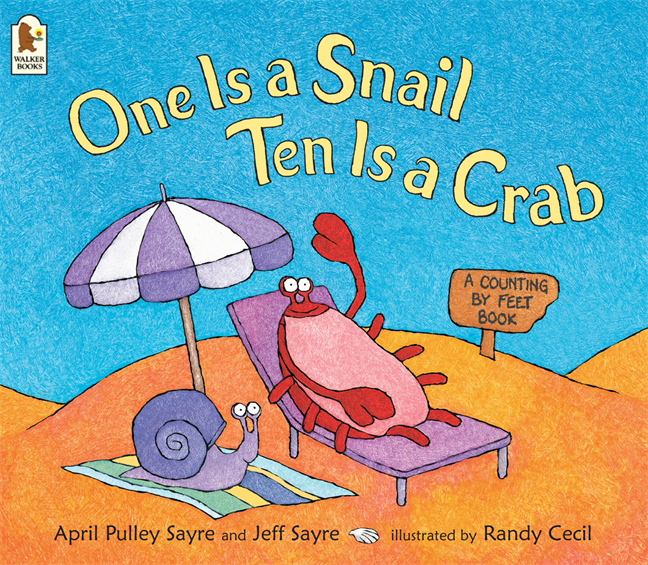 by April Pulley Sayre and Jeff Sayre
by April Pulley Sayre and Jeff Sayre
If one is a snail and two is a person, we must be counting by feet! Children will love this hilariously illustrated introduction to simple counting and multiplication with big feet and small – on people and spiders, dogs and insects, snails and crabs – from one to one hundred!
Strategies/Skills Used
Reading Strategy 1: Access background information.
Reading Strategy 2: Predict what will be learned or what will happen.
Reading Strategy 5: Make mental pictures.
Reading Strategy 11: Make inferences and draw conclusions.
Writing Skill 1: I generate ideas in a variety of ways.
Writing Skill 2: I organize my ideas based on my purpose for writing.
Writing Skill 3: I use a variety of sentence lengths and patterns.
Writing Skill 4: I write so my thoughts flow smoothly and are easy to read.
Writing Skill 5: I carefully choose the most effective words to express my ideas.
Writing Skill 7: I use my personal style to make my writing unique.
Writing Skill 8: I re-read, reflect, revise and edit.
 TEACHING THE ACTIVITY: PRE-READING
TEACHING THE ACTIVITY: PRE-READING
(1) Invite students to try and solve the following question: “If one is a snail and two is a person, what is three? What is four?”
 (2) Have students work in small groups to come up with an answer and an explanation that supports it. Using the Numbered Heads tactic described in Beyond Monet, call on a number to share out each groups’ findings.
(2) Have students work in small groups to come up with an answer and an explanation that supports it. Using the Numbered Heads tactic described in Beyond Monet, call on a number to share out each groups’ findings.
 (3) Draw or post a Venn Diagram #1 on the board and discuss with students the characteristics of the snail and the person.
(3) Draw or post a Venn Diagram #1 on the board and discuss with students the characteristics of the snail and the person.
 (4) Show students the cover of the book One Is a Snail, Ten Is a Crab. Add another circle to your diagram to create a Venn Diagram #4 to continue your discussion, now including the characteristics of the crab. Guide students towards noticing the number of feet they have and how they represent their number.
(4) Show students the cover of the book One Is a Snail, Ten Is a Crab. Add another circle to your diagram to create a Venn Diagram #4 to continue your discussion, now including the characteristics of the crab. Guide students towards noticing the number of feet they have and how they represent their number.
(5) Explore the cover of the book and make predictions about the story.
 TEACHING THE ACTIVITY: DURING READING
TEACHING THE ACTIVITY: DURING READING
(6) Make magnetic animals (several copies and cut-outs of each animal in the book, with a magnet or tape on the back) so that you can manipulate and play with them on the board as you read the story to the class.
(7) Read the story One is a Snail, Ten is a Crab aloud to the class. Stop periodically and use the magnetic animals on the white board to discuss characteristics of the animals and explore different combinations of feet to represent each number.
(8) Provide students with an 11 x 17 sheet of paper folded into ten boxes. (First, do a hot-dog fold –fold the paper in half lengthwise – then fold the hot dog into five even squares. Unfold to find ten boxes.) Have students use the Listen-Sketch-Draft strategy to sketch the different characters from the story and the numbers that they represent. Other squares should be used to summarize key ideas. Students may draw pictures of the animals or write key words about the story.
(9) As you read, prompt students to think about different ways to represent numbers using the different animals. Ask students questions such as, “If five is a dog and a snail, could five be anything else?” “Could it be five snails?” “Could five be two people and a snail?” “What could seven be?” “How many dogs will make 12 feet?” Finish reading the book, stopping periodically to explore different combinations of feet that have a sum of the next number.
(10) Ask students to consider if there are any other characteristics that they would be able to count using the same characters.
 TEACHING THE ACTIVITY: POST-READING
TEACHING THE ACTIVITY: POST-READING
(11) Use the Write like a Writer strategy to have students recreate their own version of the story using a new set of characters and possibly a new set of characteristics.
(12) Ensure that students are using the same sentence structure modeled by the author”
- One is a ________, two is a ________ …
- And that means…30 is ________ or ________ …
(13) Provide students with a specific number or range of numbers that you would like to see represented in their stories (e.g. 15, 40, 50–100) and ask students to use a variety of new characters and different combinations of them in the story to portray that number within the new context.
(14) Provide opportunities for students to share their stories.
 TEACHING THE ACTIVITY: POST-READING EXTENSION
TEACHING THE ACTIVITY: POST-READING EXTENSION
(15) This books links directly to the multiple-representation of numbers in the math lesson. Students can show the numbers of feet using tally charts, cubes, drawings, words, and so on.